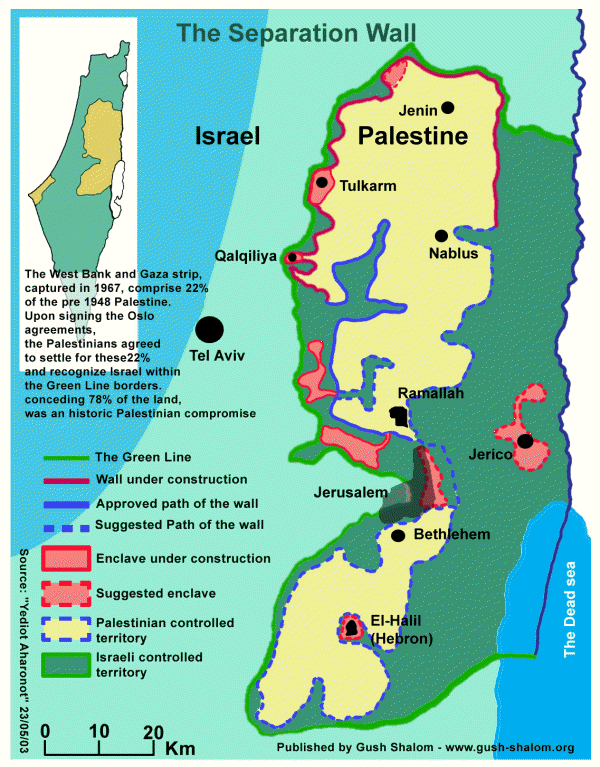
september 2004
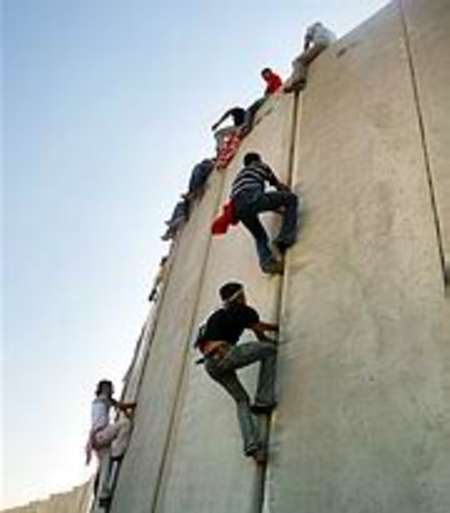 bbc photo
bbc photo
The Apartheid Wall
by Rezeq
Faraj©
- Introduction
- Background
- Political context
- Impact: economic, social, water and environmental consequences of the wall
Introduction:
Lately the apartheid Wall, as called by the Palestinians, and the Security Fence as the Israelis call it, has been the centre of international attention. The international Court of Justice called for its demolition, being illegal and in contradiction with international laws and the fourth Geneva Convention. It has also among other things called for reparation for all damage caused by its construction to those who suffered from the building of the Wall. The court even called on the United Nations to take action to end the illegal situation and to ensure compliance by Israel with International Humanitarian law.
The United Nations General Assembly has asked the International Court of Justice, the highest authority in the world for its morally binding opinion ; also, to study the questions provoked by the Wall and publish its opinion on its construction by the Israelis in the West Bank, on the Palestinian territories occupied by Israel since the war of 1967. The court’s decision is not binding but morally it is extremely important in eyes of world public opinion.
The United Nations General Assembly, following the decision of the court, had voted by an extremely rare high majority of 150 nations supporting the court’s decision, and calling on Israel to tear down the Wall and respect the court’s decision and international laws.
Israel voted against the court’s decision and simply said no. Israel said it would only abide by the decisions of its own courts. By refusing to abide by the international decisions, Israel, relying on the unwavering support of the only world super power U.S.A., showed unprecedented arrogance in face of world opinion. Why does Israel act the way it does in face of international laws and a great number of United Nations resolutions including the United Nations’ Security Council resolutions?
The Background:
To answer the above question we need
to go to the background. Contrary to world wide
media-reports of the apartheid wall that it is being
built on the borders of the Green line or the 1967
borders, it is actually being built among most fertile
lands of the West Bank on Palestinian territories. When
it is finished, it will have taken over close to 10 % of
the 22% of the land, which composes Gaza and the West
Bank, that is, the land occupied by Israel during the
1967 war. During the first Palestinian Intifada
(uprising), various Israeli governments had discussed the
building of a Wall. It was only in April 2002, that the
ministerial committee dealing with the Wall ordered the
start of construction in the West Bank, including
Jerusalem. Days after of that decision, and before
publishing the maps, according to B’tselem
(Israeli Human Rights organization), the Israeli
Occupation Army started confiscating land and uprooting
trees in the northern part of the West Bank. The security
establishment made changes to the maps but those were
never published. Only after months of demands by the
Palestinians and Israeli human rights organizations the
maps were made public. During the same period the
confiscation of land by the military continued and grew
in magnitude and size. The building of the Wall is now in
its second year. It is supposed to be over 370 kilometres
long, which is the length of the green line. “The
separation barrier will severely infringe the rights of
hundreds of thousands of Palestinians. The gross
violation of their freedom of movement will restrict
their access to work sites, medical treatment, and
educational institutions” according to
B’tselem last bulletin of July 2002
Here are some pictures of the Wall taken by me in July and August 2004.
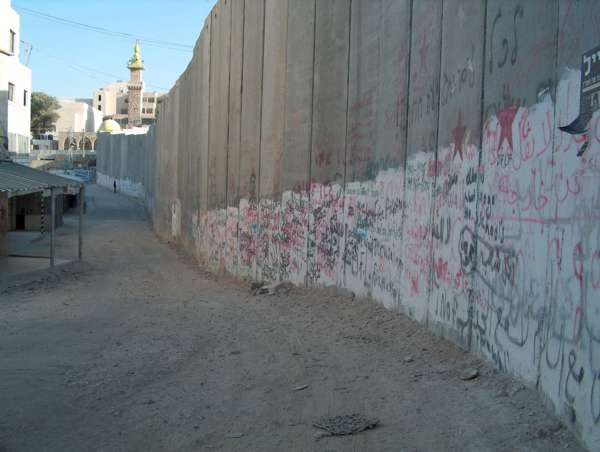
Abu-Dis, part of Jerusalem Wall After Kalandia Checkpoint
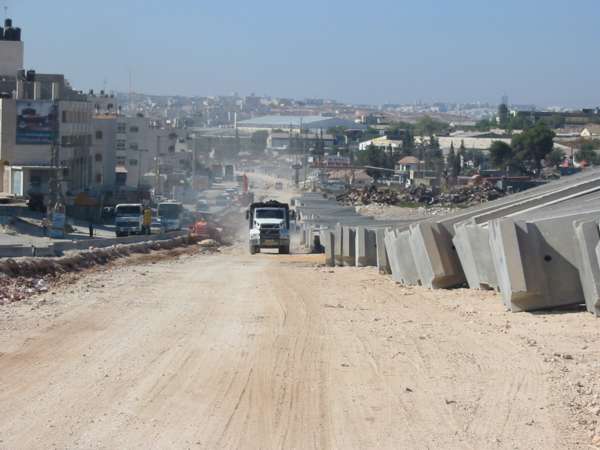
Under
construction near Ram-Dahia,
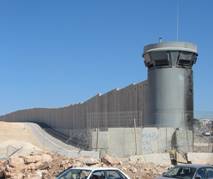
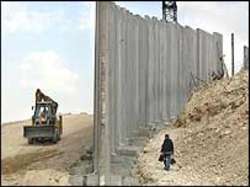
. Before Kalandia checkpoint
Most of the Wall is built like the pictures above. The Israelis call it a fence. Close to 10 meters in height, with control towers, electronic sensors and cameras. It divides villages from each other, divides cities from each other, and separates neighbors and parents from each other and their land. It destroys thousands of olive and citrus trees. It denatures the environment and makes it ugly looking. It makes cities like Qualquila open sky prisons where people can’t get in or out except through the checkpoint which Israelis close and open according their will. The Wall links the settlements with each other and in the process grabs a huge chunk of the Palestinian land (close to10% of the 22% left to the Palestinians for their supposed State). It makes the creation of A Palestinian State virtually impossible.
Added
to the Wall there are the bypass roads for Israelis, for
settlers, for foreign diplomatic core and some
international organization like the UN. Driving through
some of them you don’t see the Palestinian villages
scattered around. These roads cut through the Palestinian
land. The Palestinians can’t visit the other part of
the village or work their land. They have to go the
distance to some checkpoint to cross the road.
Harassment, humiliation and economic deprivation are the
name of the game for the Palestinian population that
lives around these roads or the Wall. These bypass roads
link settlements with each other and with Israel. The
checkpoints, infringe on the Palestinian freedom of
movement. Humiliate the Palestinian population, and adds
to the problems of unemployment, deprivation and economic
hardship.
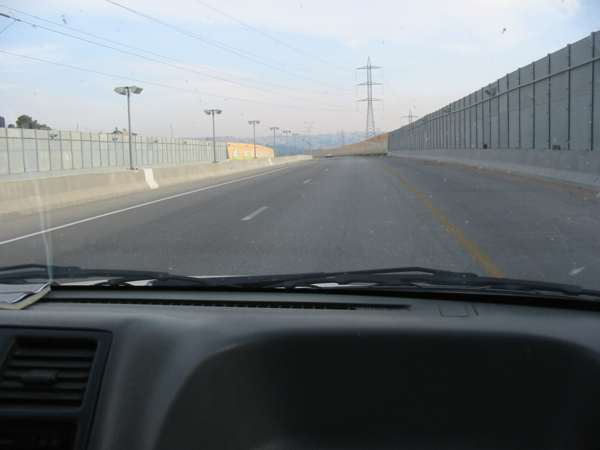
The Forbidden Roads
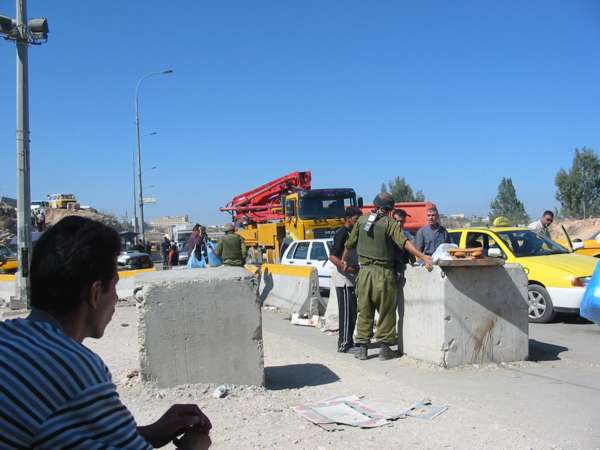
Bethlehem
Checkpoint
B’tselem calls these roads the forbidden roads. See the map and text of B’tselem on the effects of these roads and the restrictions for West Bank Palestinians
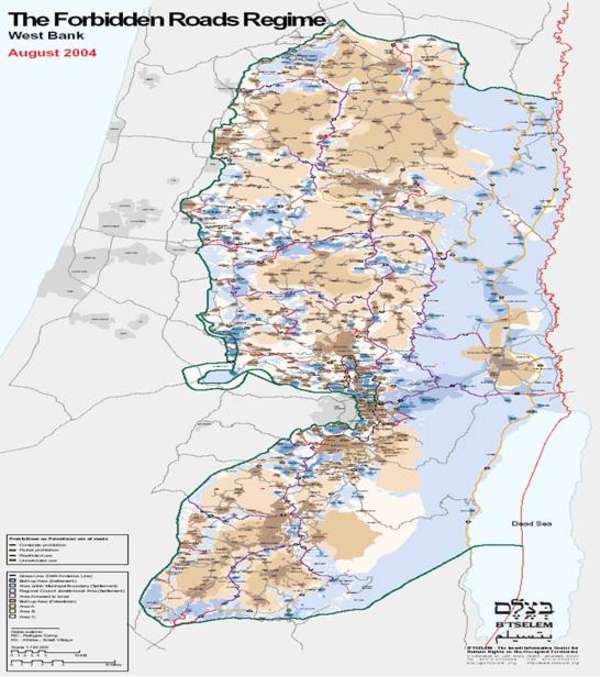
The Discriminatory West Bank Road Regime.
In its new report, B'tselem finds that Israel restricts
Palestinian travel on forty-one roads and sections of
roads throughout the West Bank, totalling more than 700
kilometres of roadway.
By unlawfully discriminating against Palestinians based on their national origin, the Forbidden Roads Regime is reminiscent of the apartheid system that existed in South Africa. The regime violates fundamental principles of international law that are binding on the State of Israel.
- Permits for Palestinians to travel on restricted roads are issued at the sole discretion of the Israeli security establishment. Rejections are given verbally and without explanation. According to the head of the Civil Administration, Brig. Gen. Ilan Paz, "There are no definitive clear criteria for examining requests for a permit."
- The Forbidden Roads Regime has been in operation for years, but the rules and regulations for its implementation have never been issued in writing. Thus, Israel frees itself of accountability and increases the arbitrariness with which it enforces the regime.
- The Forbidden Roads Regime operates under the premise that every Palestinian is a security risk. Based on this premise, the Roads Regime violates the rights to freedom of movement and to equality of hundreds of thousands of Palestinians in the West Bank. Israel has an obligation to safeguard the lives of its citizens. An obligation that does not allow it to cause such harsh, extensive, indiscriminate, and prolonged harm to the local population.
Political context:
Under the British Mandate of 1948 -1947, Palestine borders were established to include 27,000 square kilometres. In 1947 the United Nations had adopted a Canadian Plan for the partition of Palestine into two states, a Jewish State and an Arab State
Looking at the map below makes you understand why the Palestinian refused it.
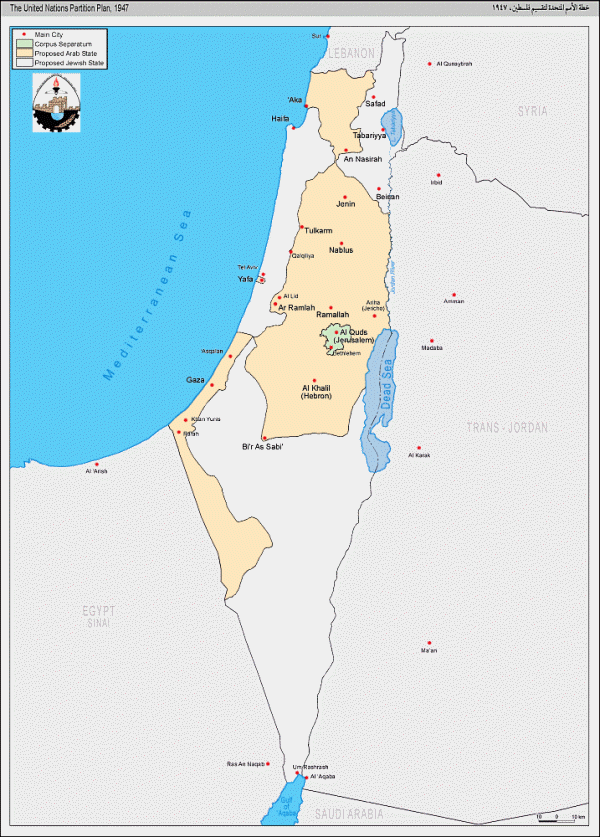
Copyright ã Applied Research
Institute – Jerusalem
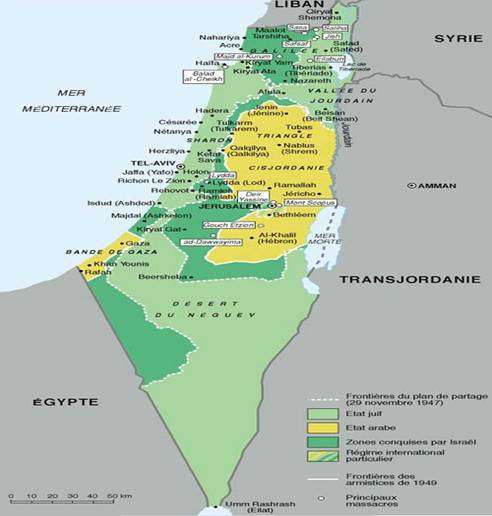
Source : Le Monde, file: la déchirure
Legend: Pale green = Jewish State Yellow and dark green= Arab state Dark green= Territories taken by Israel in 1948 Yellow, Green colors= Jerusalem or special international regime Yellow = West Bank, Jerusalem and Gaza strip occupied by Israel in 1967
They
refused the partition of their land. Over 65% of the
population was Palestinian. The Jews, channelled through
immigration, reached close to 35% of the population
particularly after the holocaust. tPalestinians had
nothing to do with it but paid the price for it. The
Jewish population didn’t own much of the land and
when the partition plan was adopted by the United
Nations, the Palestinian refused it. The plan gave the
Jewish minority (35% of the population), 56% of the land
and allocated to the Majority (65% of the population or
the Palestinians), 44% of the land. Added to this, the
partition plan denied the Palestinian people their right
to self-determination and enforced their control and
domination by the new colonial minority. The Palestinians
thus rejected the plan.
In 1948 the Israeli grabbed 13% more of the land (Dark
green section of the map) and thus during the signing of
the armistice, Israel controlled 78 % of historic
Palestine (pale and dark green of the map). The rest went
under Jordanian and Egyptian control. The expansion
continued. In 1967 Israel occupied the rest of the West
Bank, Gaza (The yellow section of the map) and other Arab
territories.
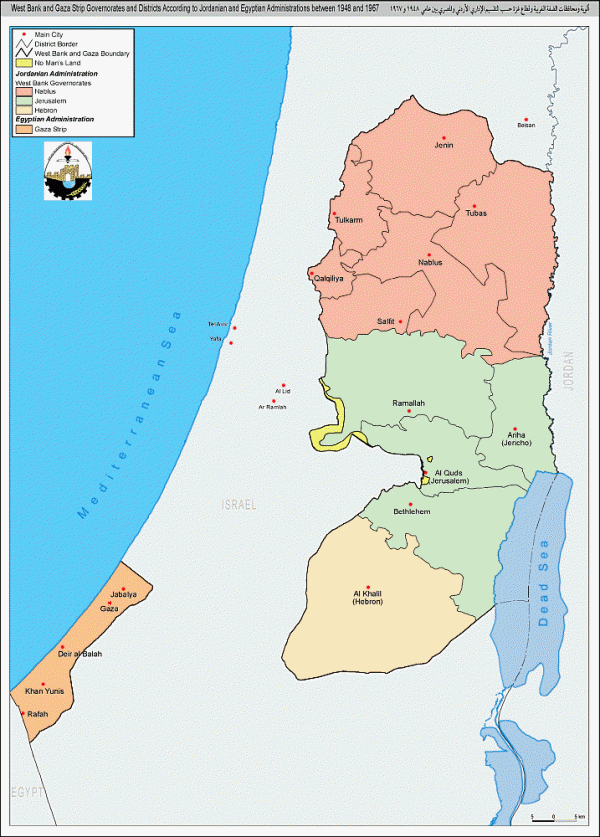
Copyright ã Applied Research
Institute – Jerusalem
Following this 1967 occupation Israel started an immense
colonization of Palestinian land and practised
segregation against the Palestinian population. Israeli
long-term vision is to incorporate much of the land as
possible without its population. That’s why we have
a refugee problem. It started in 1948 and continued in
1967. We have over 5 million Palestinians refugees
spirited all over the neighbouring countries and around
the world including the West Bank refugee camps, and
those in Gaza and Israel proper. The 3 million
Palestinians living under the occupation in Jerusalem,
the West Bank and Gaza are now under siege.
Israelis trying in different ways to achieve Theodor
Herzel colonial dream of a Jewish State from the sea to
the river without any of the indigenous population but
only Jews. The destruction of over 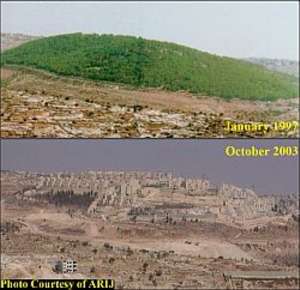 400 Palestinian villages in 1948
and the continuation of this until today have only one
objective: to have the land without its people.
400 Palestinian villages in 1948
and the continuation of this until today have only one
objective: to have the land without its people.
The creation of Settlements in the occupied territories
started in 1967 and never stopped. Today, including the
Oslo years, there are over 400 thousand Jewish settlers
in the Palestinian territories in uncountable numbers of
settlements. All successive Israeli governments
participated and worked toward achieving Theodor Hertzel
objective in his book “Juden Staat” or the
Jewish State published in 1896. During the Oslo years, or
the so-called peace negotiation, the Israeli never
stopped the creation of Settlements and actually doubled
the number of settlers and settlements. Ariel Sharon,
Israel actual Priminister is following in the footsteps
of the precedent governments and intensifying the
colonization of Palestinian land.
- Impact: economic, social, and water consequences of the Wall.
The business impact.
The Palestinian economy today is in a
shambles. There is virtually no economy. Over 37 years of
Israeli occupation of the West Bank including East
Jerusalem, and the Gaza strip, where tax collection is
imposed on the population to finance the Israeli Military
and its actions, culminated in this disastrous economic
situation. Little or non-existence of public services,
like medical, educational, road or other infrastructures
are consequences of the occupation. When the Palestinian
created some infrastructure with the help from outside
money, the Israeli occupation forces (IOF) destroyed it.
During the Oslo years, the situation got worse. The
unemployment skyrocketed due to the Israeli closure
policy. The checkpoints, the curfews, the house
demolitions, the assassinations, the uprooting of
millions of olive, citrus and other productive trees, the
confiscation and expropriation of land, the restriction
of movement, the creation of separate enclaves within and
the non-contiguous territories added to the misery of the
Palestinian population and their economic situation, and
virtually destroyed the Palestinian economy. During this
second Intifada, the destruction of the economy and
Palestinian institutions took unprecedented strides.
While the destruction of the infrastructure continued,
air raids, tank fire, shelling, missiles, shooting at
houses, workplaces, Schools, public buildings as well as
the health facilities took place at a frightening pace.
Added to that the razing of tens of thousands of dunums
of agricultural land , as well as mentioned earlier, the
uprooting of millions of trees and the destruction of the
live-stock , added and still adds to the disastrous
economic situation which prevails now a days in the
Palestinian territories occupied since 1967.
The impact of the Wall on the land, in its first
phase only, exceeded 160,000 dunums of land destruction
and the uprooting of thousands of trees. Much of the land
that is saved from the bulldozer is inaccessible to their
owners because they happen to be on the wrong side of the
Wall. The Wall disconnects villages from cities and from
each other. The city citizens depend on agricultural
products from the villages and villagers depend on
marketing their products to the cities. The result is
disastrous for both, the city dwellers and village’s
inhabitants. For example in the district of Qualquila
alone, the unemployment jumped from 16% to 70% according
to Palestinian central bureau of statistics. I leave to
your imagination the impact of this apartheid Wall when
the construction of 370 kilometres or so is finished. The
Wall, from producers to deliverers and consumers, even
exports to Jordan has a negative impact on all aspects of
business life. Israeli goods and products are replacing
the Palestinian goods and products. Adding this to the
above mentioned, consequently,shows that what is left of
the Palestinian economy is completely dependent on
theIsraeli economy and therefore there is now no real
Palestinian economy in the West Bank and Gaza.
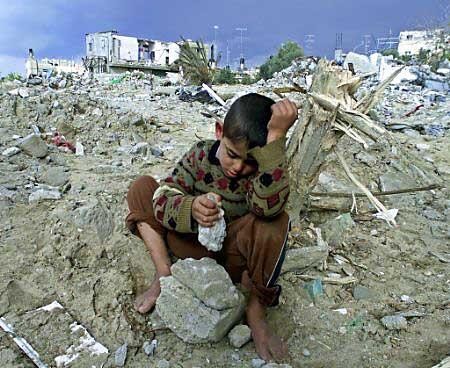
The social impact
of the Apartheid Wall is integrated into the political,
economic and environmental systems. They are all linked
and intertwined with each other. The unemployment,
the poverty, the destruction of property and health
services is inevitable part of the consequences the wall
generates. The restriction of movement (checkpoints), the
increased unemployment, the ties between people living in
different villages and localities around the Wall which
is severely hindered, the living under constant fear of
hunger, living in closed areas, cities and villages which
resembles open-sky prisons, the disintegration of rural
societies and their relationship to the land and many
other negative consequences on people’s life are all
now caused by the Wall. The restriction of movement, on
education at all levels, on health and reaching the
desired doctor or hospital for various treatments, even
religious worship is restricted and affected by the above
mention restrictions and finally the fear of eviction and
forced migration to other peripheral countries. All of
this impacts severely and negatively on Palestinian
society and its functional ability is the minimum of
normality.
Water:
The impact of the occupation and the Wall on the Palestinian use of water, the important natural resource of the West Bank and Gaza is horrendous. Other than the Jordan River, there are three underground aquifers in the West Bank: The aquifer of the Northeast, the aquifer of the West and that of the East. Those water resources are all in the West Bank and they are the most important resources of underground water in the whole Middle East. There is another one in Gaza of lesser importance in size. On the map below, the arrows point to the direction of water flow.
(Source: ARIJ (Applied Research Institute –
Jerusalem)
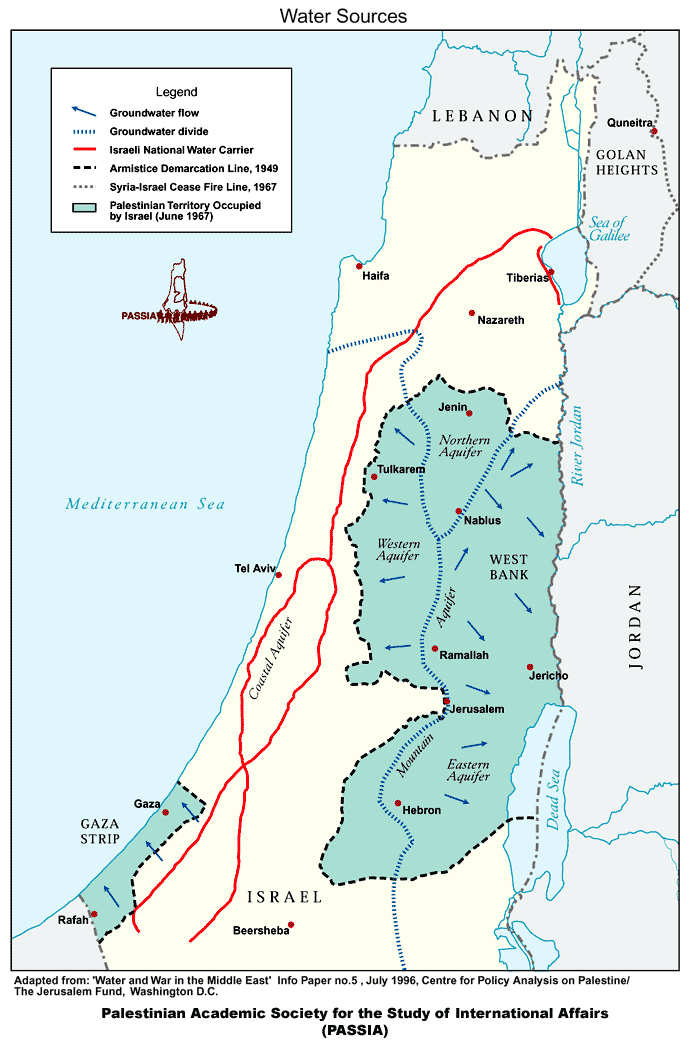
The four
aquifers have 734 CMM millions of cubic meters of waters.
They were taken over by the Israelis and the water is now
being sold to the Palestinian at a high price, which adds
to the hardship of the population. An Israeli company is
selling them their own water. Today the ratio is 6.9:1.
Proportionately one Israeli uses 7 times more water than
a Palestinian.
Given the importance of water, there was even a special
committee on the question during the Oslo negotiations.
During the negotiations Israel recognized the rights of
the Palestinians to the water in West Bank, however no
decision on water was taken and the final decision was
postponed to be included in the so called final status
negotiations which never took place.
Meanwhile, Israel offered the Palestinians 28.6 CMM per
year; the Palestinians need however 70 to 80 CMM a year.
After 7 years of negotiations the Palestinians have
received only 13 CMM of water.
Israel took control of water resources immediately after
1967 when the occupation started. Since then a
discrimination policy was officially installed. And since
then, thousands of Palestinian families suffer from water
restriction and interruption particularly during the
summer, while the settlements have running water all year
round. Statistically speaking, Israel uses 86 % of the
waters of the region. The Palestinians use 8 to 12% and
the settler’s use 2 to 5 %. After 37 years of
occupation there are still over 180 villages of the West
Bank, which have no water distribution system.
One of the things Israel promoted after 1967 war was the
application of its own laws in the occupied territories,
one a law dated from 1959. This measure made the
hydraulic resources public property controlled by the
state of Israel. This Law forbade the Palestinians to
freely use their own waters resources. The apartheid
system started then by imposing arbitrarily military
decrees which spread to legislative and administrative
control of the West Bank. They forbade Palestinians use
of their own water wells, thing that didn’t exist
before 1967 under the Jordanian law. They even forbade
the Palestinians to maintain and clean their own wells.
The Israelis give very few Palestinians permits to dig
for new wells.Since 1967 they gave less than a dozen
permits .
In 1975, the Israelis started a quota system in the
occupied territories. On one hand the Israelis can use
water at will without any restrictions; but on the other
Palestinians who use more than allocated quotas are
inflicted with heavy fines. This quota for Palestinians
did not go up since 1975. However use of water by the
settlers was raised by 100 %. The Jewish National Fund
and the Israeli company Mekorot, which is also controlled
by JNF, control this institutionalized discrimination
against the Palestinians. Their only objective is to
support the interest of the Israelis. The water shortage
in the occupied territories is due to voluntary
negligence of the Israeli government and it agents like
the JNF, the Jewish Agency and Mekorot. These agencies
are known for their support to existing settlements and
the creation of new ones. The shortage of water is
chronic in the Palestinian territories including
hospitals. The settlers and Israeli population however
have water at will all year round. Sometimes in the
summer, in the Palestinian territories it is easier to
find coca-cola than water. The Israeli practice goes
against any elementary human rights laws and
international laws including the Geneva conventions with
regard to a population under occupation.
All of this didn’t seem to be enough for the
Israelis. Their latest invention is the Apartheid Wall.
The first phase of its construction around Qualiquila,
Toukarem and the Jenin district in the North of the West
Bank have seen the destruction of fifty water sources.
Many villages depend on 30 wells of the fifty available
of the surface water for their agriculture. Added to this
the restriction of movement, and the deterioration of
economic conditions forced the farmers to use cisterns
which are not viable or dependable because of
checkpoints, the closures for long periods of time, the
long distances caused by the detours and the price of
water which was raised to over 80 %. This in itself
became an economic burden. 2/3 of the revenue goes to
buying water. The Wall makes so many detours, which
isolates communities of their water sources, which are on
the other side of the wall if not destroyed. People are
isolated from their land. The Wall thus destroys the
water sources on its route or these resources are on the
other side of the Wall. In few words the Wall destroys
and engulfs the water resources, which are vital to the
existence of agriculture and to the very health of the
population for consumption and for all domestic tasks.
The population that is close to 30 or 100 meter of the
wall is now being threatened with house demolition and
confiscation of their land. This is just a glimpse of the
effects of the Wall. Added to that, when the construction
of this monster is finished over 400,000 thousand
Palestinian will be isolated from the rest of the
population. 200,000 thousand will be isolated in the
Jerusalem area alone.
To summarize the effect of the wall: No Viable
Palestinian State is possible.
Rezeq Faraj©Aug.2004
